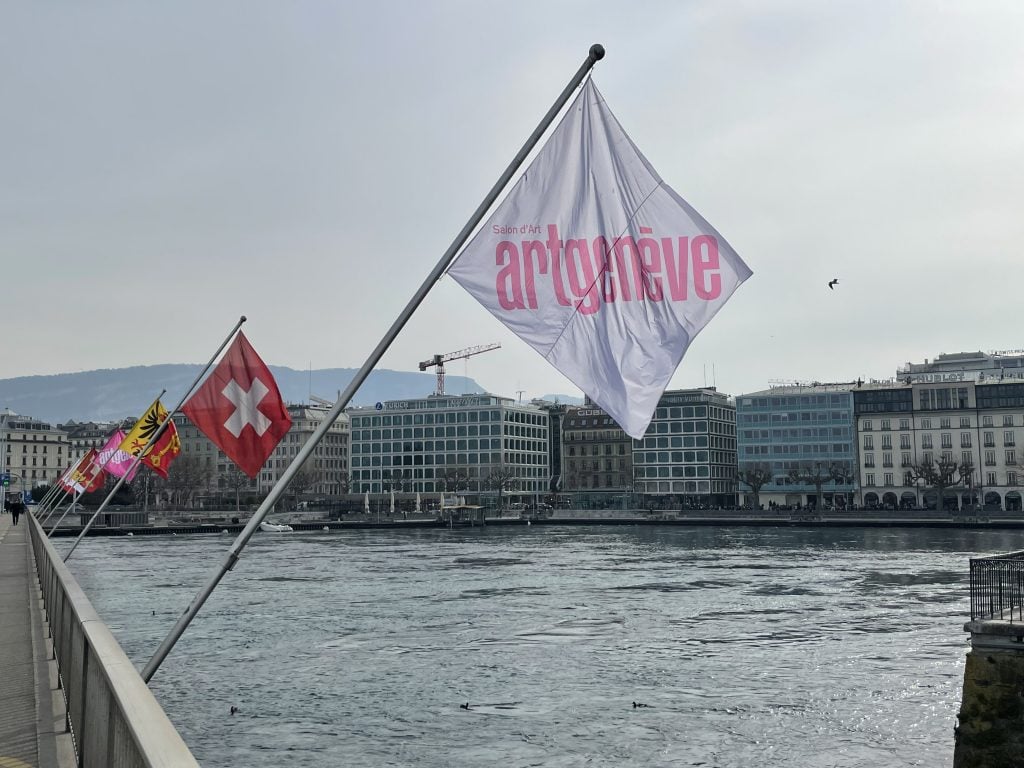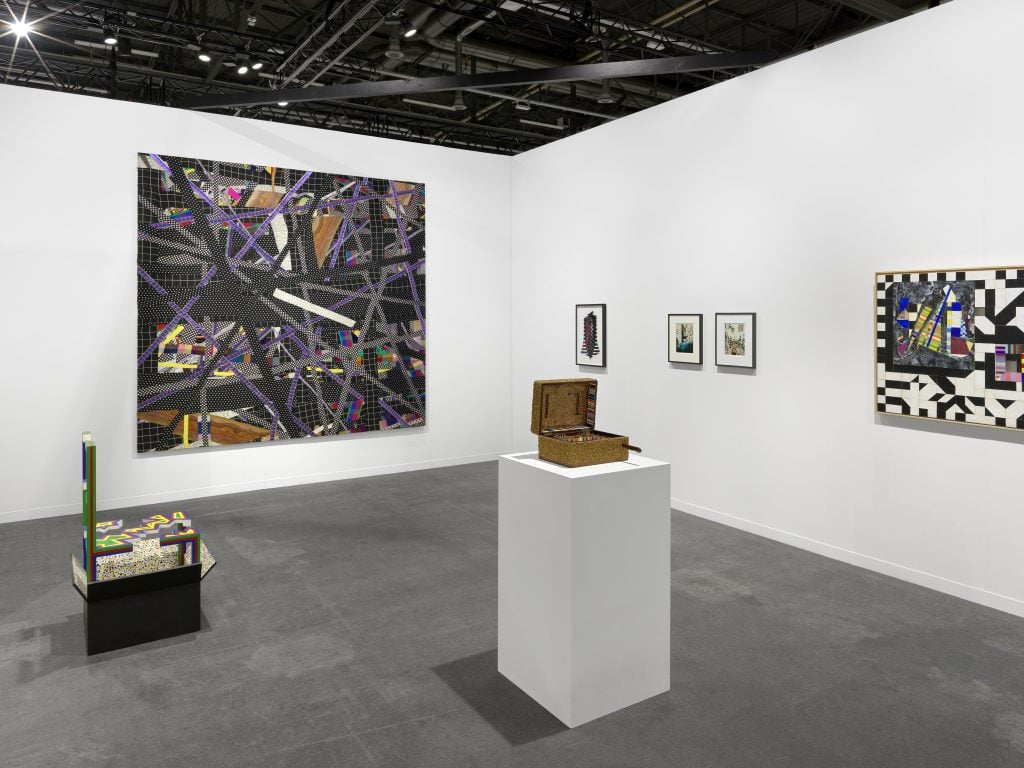Artnet News Pro
The War in Ukraine Didn’t Dampen Sales at Art Genève, and Some Dealers Are Giving Proceeds to Relief Efforts
Pace Geneva donated all of its proceeds from the fair to aid Ukraine.

Pace Geneva donated all of its proceeds from the fair to aid Ukraine.

“I’m not buying art by a Russian, that’s for sure,” I overheard one collector telling a dealer at the preview of Art Genève last Wednesday. Whether it was a dark, timely joke or a real personal boycott was unclear, but the war was certainly a subject on everyone’s mind at the Swiss art fair last week.
Art Genève, the curated, boutique art fair that is now in its 10th year, opened just a week after Russia invaded Ukraine a few hours plane ride away. I should say that this is a notably different Switzerland, too. The country that has remained neutral since 1815 took the surprising step to impose sanctions on Russia just days after the invasion.
“Fucking finally!” declared one VIP who I sat beside during at the fair’s opening dinner, an event attended by 1,300 people. She was donning a royal blue dress and a golden yellow sweater last Thursday, the colors of the Ukrainian flag and a new symbol of European solidarity.

Art Genève’s new sculpture section, curated by Balthazar Lovay and Jelena Kristic. Photo: Julien Gremaud.
Toward the end of the second fair day, an army of servers quietly maneuvered around guests to install scores of long, white-clothed dinner tables throughout the halls of the art fair. (Galleries buy tables and dine with their VIPs in front of their booths.) Servers popped in and out of view from behind kitchens that were apparently hiding between the booth walls.
Despite the underlying anxiety, Art Genève maintained a bright attitude, which may have had something to do with the medical masks coming off, finally.
The fair, which had been postponed from January to March amid surging infection rates, celebrated its 10th anniversary at the Palexpo, its longtime venue beside the airport (and freeport). Beyond both, one can see the snow-capped peaks of Mont Blanc, while from the exposition center, the city slopes down to Lake Geneva, around which are opulent streets, luxury hotels, Swiss banks, and art galleries.
The fair remains very Swiss, by which I mean buttoned-up, discreet, and moneyed, but there is a lot at Art Genève that departs from traditional fairs. For one thing, the fair tries to keep its numbers down to less than 100 booths—this year, there are 88.

Galerie Xippas at Art Genève. Photo: Julien Gremaud.
The fair perimeter is lined by 30 institutional presentations of non-selling shows. The aim is to provide context for the commercial galleries, which this year included major players such as Almine Rech and Kamel Mennour.
Music is woven throughout the fair as its founder, Thomas Hug, is also a composer. There is also one curated booth dedicated to sound. After the VIP dinner, Hug sat at a grand piano, which was installed in front of a $200,000 plant-life installation by Meg Webster at Paula Cooper Gallery, and casually played a few songs.
Sitting in the UBS lounge, Hug explained that these kinds of details, from curated projects to a sense of intimacy, are foundational. “It’s really in the spirit of this art fair to be a salon d’art, meaning a living room. It’s about the human dimension,” he said.
Like its sibling fair, Art Monte-Carlo, which takes place in Monaco in July, Art Genève takes a specific tack of targeting collector-rich, tax-favorable areas, and staying small and focused. It is a model that seems to work well, although the fair’s plan to expand once more this fall, to Moscow, is on hold indefinitely.

Photo: Artnet News.
There were Russian collectors at the fair. One gallery director said she believed they “feel the pressure and don’t really know what will happen.” She added that one Russian client pulled out of a purchase in London because, overnight, he couldn’t pay due to sanctions.
“It’s very concentrated, and we met a lot of people we’ve never seen before at other art fairs,” said Sebastian Klemm, who was attending the fair from Berlin for the first time. “The conversations are really good and the collectors, who seem to come here and to Art Basel, are really savvy.”
The gallery sold works by Jan Groover and Thomas Arnold by the second day of the fair.

Pace Gallery’s solo presentation of work by Lucas Samaras. Photo: Annik Wetter.
That core crowd at the fair are the French-Swiss collectors. Dealer Thaddaeus Ropac, presenting for the first time, noted that he had also seen collectors from Germany, Belgium, and Scandinavia. The gallery’s top sales in the first two days included a cast iron sculpture by Antony Gormley, which sold to a private Swiss collection for £400,000 ($524,000). A blue-hued portrait of Italian master Titian by Yan Pei-Ming was nabbed by a private French collection for €300,000 ($325,000).
In a spontaneous gesture, Pace’s Geneva director Valentina Volchkova, who is Russian, decided with her team to give all the proceeds of their sales at Art Genève to the United Nations High Commissioner for Refugees. “We sat here on Monday with blank walls and we were watching the news on our phones. We asked ourselves, ‘What are we doing?’ There are people losing their homes just a few hours from here,” she said.
Lucas Samaras, to whom Pace’s booth was dedicated, agreed to donate his share of the proceeds as well.
The world, especially in Europe, remains an uncertain place, but coming together for business, community-building, and solidarity, feels more crucial than ever.
“On the one, hand, there is this darkness, and, on the other hand, we must go on,” Hug said. “We can be both sad and we can also continue to support each other.”